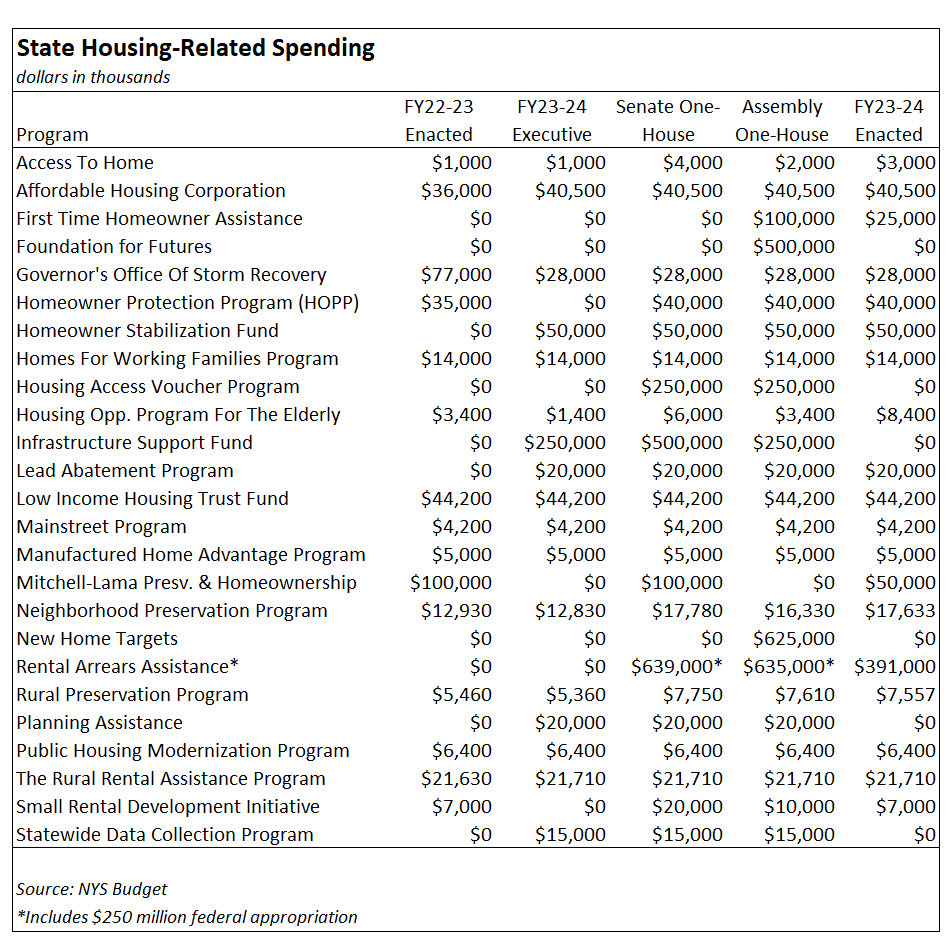This week, the Governor and Legislature finalized the $229 billion state budget, excluding any plan for increasing housing supply and addressing exclusionary zoning across the state. In her executive budget, Governor Hochul proposed the Housing Compact – a bold statewide growth strategy that would have complemented the 5-Year Affordable Housing Plan, addressed exclusionary zoning while providing flexibility for localities, incentivized affordable housing and supported our aggressive climate goals through increased density near public transit. The Senate and Assembly responded by proposing incentive driven plans in their one-house budgets. There were clear opportunities for compromise but negotiations failed due to fierce opposition. We are extremely disappointed to see another year of inaction on our housing supply crisis. This budget guarantees that we’ll continue to see skyrocketing rents, existing patterns of residential racial segregation reinforced, first time homebuyers locked out of the market and seniors unable to downsize in or near their own communities.
Over the last several months, NYHC advocated in support of the Housing Compact as a founding member of the New York Neighbors Campaign – a pro-homes coalition of over 50 organizations across the state supporting policies to increase housing supply and create more affordable homes to tackle the state’s debilitating housing shortage. For months we met with legislators and staff, published op-eds, testified at hearings, held press conferences and released data analysis in support of these solutions. Though the state did not deliver this year, the Housing Compact prompted a serious conversation about what it will take for New York to truly address its housing crisis. It also became clear that while those in power may not be willing to pursue bold solutions, their constituents are ready for action. We will continue to fight for proven policy solutions to address the supply shortage, eliminate exclusionary practices and create the diverse housing stock needed to respond to job growth and serve New Yorkers at all different stages of life.
The budget did include some of NYHC’s other priorities as outlined in our budget testimony such as rental assistance to begin addressing the arrears crisis in public and affordable housing and continued funding for homeowner assistance and vital HCR programs.
Aid to Renters
The state provided $391 million for rental arrears for tenants that were deprioritized by the state’s Emergency Rental Assistance Program including, “tenants or occupants of federal- or state-funded subsidized public housing authorities or other federal- or state- funded subsidized housing that limits the household’s share of the rent to a set percentage of income.” Mounting arrears in affordable and public housing is a crisis that if not addressed could lead to a wave of evictions among the tenants most in need of housing and put affordable developments at financial risk.
While we are pleased to see some funding in the budget for rental arrears, we are concerned that this is not nearly enough to meet the need. NYCHA alone for example has $454 million in arrears since 2019 and in our study of just 50,000 affordable units, we found 31 percent of tenants owed at least two months rent totaling $145.7 million.
The budget excludes the Housing Access Voucher Program (HAVP), which would have provided rental assistance to families and individuals who are at risk of or are already experiencing homelessness. Funding HAVP would have provided stability to tens of thousands of low-income renters and put New York on track to end the homelessness crisis in our state. Direct relief in the form of rental assistance is a lifeline for low-income households, vital to preventing evictions and needed now more than ever as families grapple with rising costs.
Homeowner Assistance
- $40 million for the Homeowner Protection Program (HOPP), which funds much needed foreclosure prevention services. According to U.S. Census Household Pulse Survey data, an average of 7.4% of New York homeowners with mortgages continued to be delinquent in 2022 – almost 290,000 New York families. This is well over the high of 3.8% in January 2009, during the height of the financial crisis and Great Recession.
- $40.5 million for the Affordable Housing Corporation (AHC), a program subsidy for affordable homeownership development and a necessary tool to creating home ownership opportunities for low-income families in New York.
- $50 million for a Homeowner Stabilization Fund modeled after the Buffalo East Homeowner Improvement Program to finance home repairs in 10 communities across the state that have been identified as having high levels of low-income homeowners of color and homeowners in distress.
- $25 million for a First-Time Homeowner Program to provide grants for homeowners between 50 and 120 percent AMI for costs associated with home purchases such as closing costs and downpayments.
Greening Building Infrastructure
The budget will prohibit the installation of all fossil fuel infrastructure in new construction beginning in 2026 for small buildings seven stories and under and all new buildings beginning in 2029. It excludes buildings for some uses such as medical facilities, laundromats, critical infrastructure and commercial food establishments. It also excludes buildings where the local grid is not capable of handling the load and will not impact existing buildings and appliances. This is part of an ongoing effort to meet the ambitious climate goals set by the Climate Leadership and Community Protection Act.
